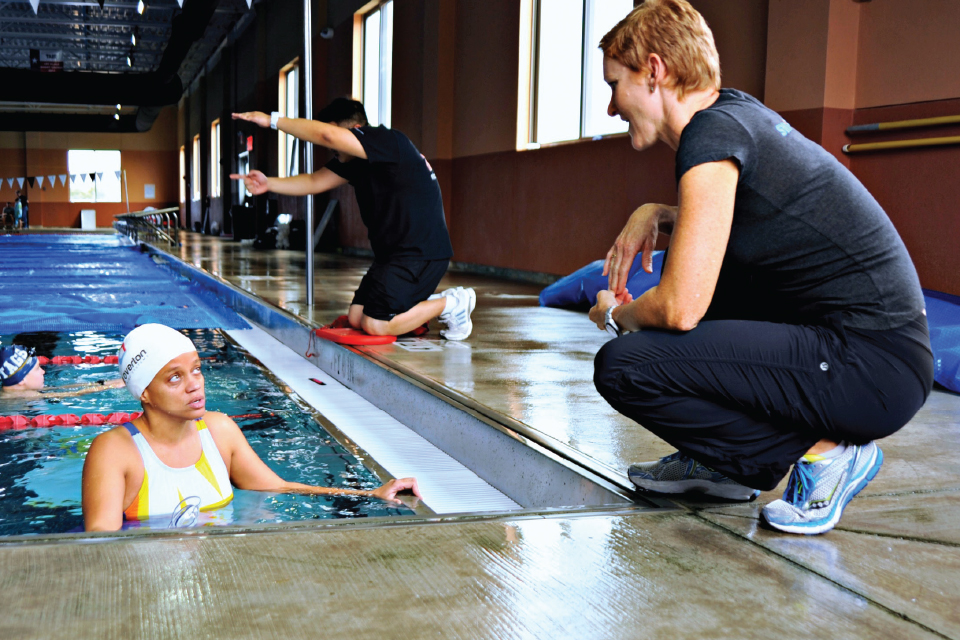Growing from Sinker to Swimmer

A5-year-old girl sinks under the water in the deep end of the local pool. Looking up, watching the surface getting farther and farther away, she feels helpless and powerless to get herself back to the top. She thinks, “I am about to die.” Suddenly, another child playing in the pool grabs her and brings her to the surface for air. This is Yolanda’s story. Her uncle had thrown her in the deep end one summer afternoon because he felt it was time for her to “learn to swim.” It seemed for many years that this experience would define her life around water. Petrified, she would not swim until she was forced to during her years in the military and in college at West Point. Yolanda then swam reluctantly, barely making it through the class, sidestroking for a passing grade. Cut to 2014, and Yolanda has just competed in her first masters swim meet. She enjoys swimming now because she is “good at it.”
How did she go from petrified, certified “sinker” to “swimmer”? With a lot of hard work and dedication. Yolanda said she enrolled her daughter in swim lessons when Jazmin was 2 “so she did not end up like me.” On another summer afternoon in 2011, Jazmin was 10 and swimming happily. Yolanda watched from the side of the pool and wondered, “What would happen if my own child needed my help in the water?” She felt that same powerlessness she had experienced as a 5-year-old. It was time for action. At last she was motivated. With a desire to become a strong swimmer, Yolanda began her journey from someone who was petrified of the water to a swimmer and triathlete.
Yolanda’s motivation to swim for her daughter’s safety helped her conquer some of the fear that held her back during her college years. Her new swim classes taught her to float on her back, giving her the confidence to know she would be OK in the water. From there, she learned backstroke, then freestyle, and was ready for more. Yolanda swam for six months under the patient tutelage of local masters swim coach Paige McCord. However, when the coaching staff changed, Yolanda found herself with no one to swim with; the new coach considered her “not good enough” to be on the team. Not to be deterred, Yolanda continued to swim on her own regularly. By this time, she had set a goal of completing a triathlon, and nothing was going to stop her. In June of 2012, Yolanda swam 200 yards in the pool during the Georgetown Super Sprint Triathlon Series.
With new goals of moving on to longer triathlon swim distances, Yolanda enrolled in the SwimVersity Level I Freestyle Clinic. The clinic was only an hour-and-a-half, but she felt inspired by the improvement she made in that short time to begin training regularly. No matter that it takes them more than an hour to drive to Nitro Swimming, Yolanda and Jazmin have made the trek every week for more than a year. Jazmin’s swim progress has equaled her mom’s; she has moved through learning all the swim strokes to training with Nitro’s Technique and Fitness group.
A defining moment in Yolanda’s swimming career occurred in July 2013 when she swam 400 meters in Texas A&M’s 2-meter deep, 50-meter long swimming pool during the TRI Aggieland Triathlon. While Yolanda had improved her technique, endurance, and confidence, swimming in deep water still occasionally gave her pause. We talked about what she could do if she panicked in the middle of the pool. Her comfort with floating on her back came in handy as a “go to” if she felt she needed it. We practiced in the deep water at Nitro and, while she did have a brief moment of panic, she quickly recovered. When it came to the race she was ready—no panic, despite obstacles such as other swimmers stopping and struggling in front of her.
To transform from “sinker” to “swimmer,” Yolanda found a deeply motivating reason to face her fear and then jumped in with both feet. Yolanda keeps herself motivated by continuing to set new goals, like the U.S. Master’s Swim Meet, and next, completing an open-water tri. She works consistently and tirelessly towards her goals, swimming twice a week between her coached sessions. Yolanda has always been a runner and uses exercise to clear her mind, relax, and de-stress, and she wants to keep working on swimming until it feels just as natural as running. The safest way to aid someone who is struggling in the water is to help him/her to the side, no matter how strong a swimmer you are. Always call for help first. If no lifeguard is available, lie on the side of the pool and offer a hand (if within reach), a shepherd's crook, or a life preserver. Always have these items at the ready around your backyard pool. Remember: There is no substitute for direction supervision. The American Red Cross has a great resource, "Swimming and Water Safety."






